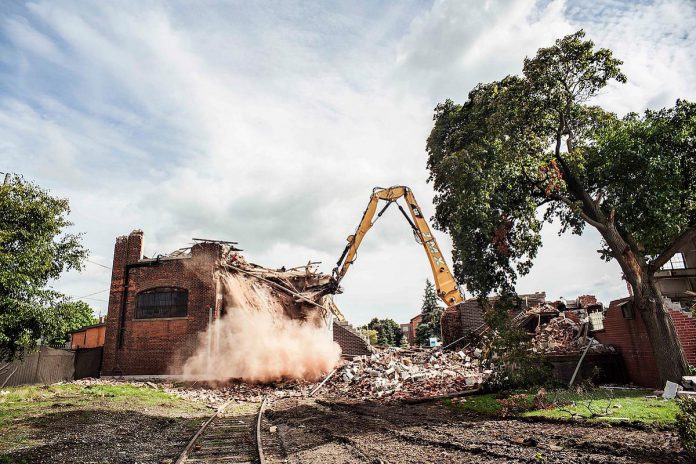
Peterborough county council has unanimously passed a motion requesting the City of Peterborough require GE Vernova to provide detailed information about its plans to demolish a large number of vacant buildings at the General Electric factory complex in downtown Peterborough — including information about the volume of demolition waste, disposal location, and whether the waste is contaminated.
The motion was passed at the county council meeting on Wednesday (October 15) in response to city council’s decision to allow GE Vernova to demolish 26 vacant buildings at the complex at 107 Park Street North in downtown Peterborough, while accepting the company’s recommendation to retain eight buildings that are currently in use or have heritage value.
County council’s motion is specifically related to the potential impact of the demolition on the Bensfort Road landfill site. Officially known as Peterborough County/City Waste Management Facility, the landfill is jointly owned and operated by the city and the county but is located in the Township of Otonabee-South Monaghan in Peterborough County.
The proposed demolition of the GE buildings is controversial because of known contamination of the industrial site with toxic hazardous substances such as asbestos over the past 125 years and the impact of a demolition on the safety of the surrounding residential neighbourhoods.
“Our staff and myself have had calls from residents who are concerned about contaminated waste being brought into the landfill, so we need some sort of assurance that that will be regulated and not happen,” Otonabee-South Monaghan mayor Joe Taylor said at the county council meeting.
“Equally as important is the fact that, even if this material isn’t contaminated, there is likely to be a huge volume of it and we have a limited amount of space and life left in our landfill,” he added. “I think it’s important that we know how much material is going to go there, and what the volume will do to the space remaining and the anticipated lifespan. I think that’s a really critical piece of information we need to have.”
Although the City of Peterborough is responsible for issuing demolition permits under the Ontario building code, city council has been advised by city staff that the municipality has no authority to require GE Vernova to identify or address environmental issues related to the demolition.
Instead, that responsibility falls under the authority of the Ontario government, including the Ministry of the Environment, Conservation and Parks through the Environmental Protection Act, which regulates the disposal of hazardous materials and the management of construction waste, and the Ministry of Labour, Immigration, Training and Skills through the Occupational Health and Safety Act, which regulates safety for workers involved in construction activities including demolition.
The motion passed at Wednesday’s county council meeting states that council “is concerned with the lack of details provided as to the demolition plan, contents disposal intentions, quantity and quality of disposal materials” and that council “requests that the City (of Peterborough) require the owner to provide detailed information, including but not limited to, detailed site demolition plans, including site disposal volumes, intended disposal location, material and site contamination testing and disposal considerations to City and County Councils.”
“We should be receiving information as to what they plan to do with it, and everything that goes with that because it is a cause of concern,” said deputy warden Sherry Senis at the meeting. “We’re just asking here to be assured that we’re in the loop and that we receive the information that is necessary.”
The motion also requests that the Ministry of the Environment, Conservation and Parks “be copied on any and all plans related to the planned demolition or site works.”
On the same day as the county council meeting, Peterborough Mayor Jeff Leal sent a letter to Environment, Conservation and Parks Minister Todd McCarthy that outlined council’s ratified motion, the demolition and heritage plan, and the need to deal with potential contaminants during demolition.
“Because of the toxicity of this site, we believe that the full weight of the Environmental Protection Act needs to be applied,” the mayor wrote in part. “Ontario Regulation 347: General – Waste Management and within the Environmental Protection Act speaks to the need for testing, characterization, classification, transportation and disposal of waste related to the demolition process. We also recognize that the Ministry of Labour will have a significant role to play in the demolition process. ”
As for GE Vernova, the company has stated that it “continues to work with the Ministry of Environment to manage the site, and is committed to working closely with City staff to plan a path forward that minimizes disruptions to the neighbourhood and meets all legislative and regulatory requirements.”
The General Electric factory opened in 1891 and, at the peak of its operations, employed as many as 6,000 workers. In 2014 and 2015, the company demolished five of its older surplus buildings as part of Project Caribou, a demolition project intended to reduce energy costs and streamline workflow at the factory. In 2018, when the factory had 350 employees, General Electric ceased its manufacturing activities on the site, with most of the buildings decomissioned and machinery and equipment removed.
Since then, GE Vernova has maintained office space for 60 employees in the site’s east block and leases several buildings in the west block to BWXT, which was originally part of GE Vernova’s nuclear energy division but became an independent company in 2016 and now specializes in nuclear components and services for government and commercial clients. Those buildings are among those that would be retained under the demolition plan.



























